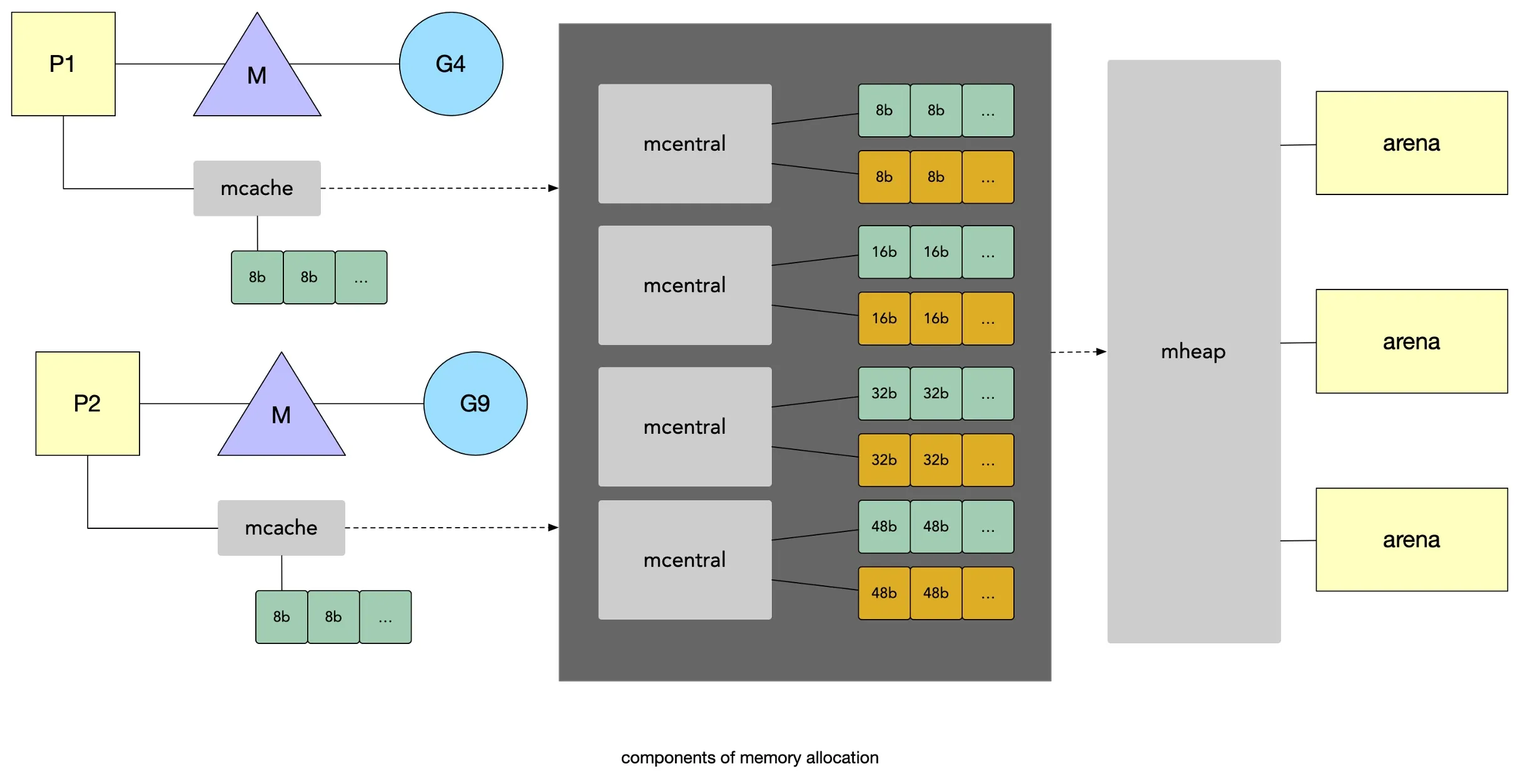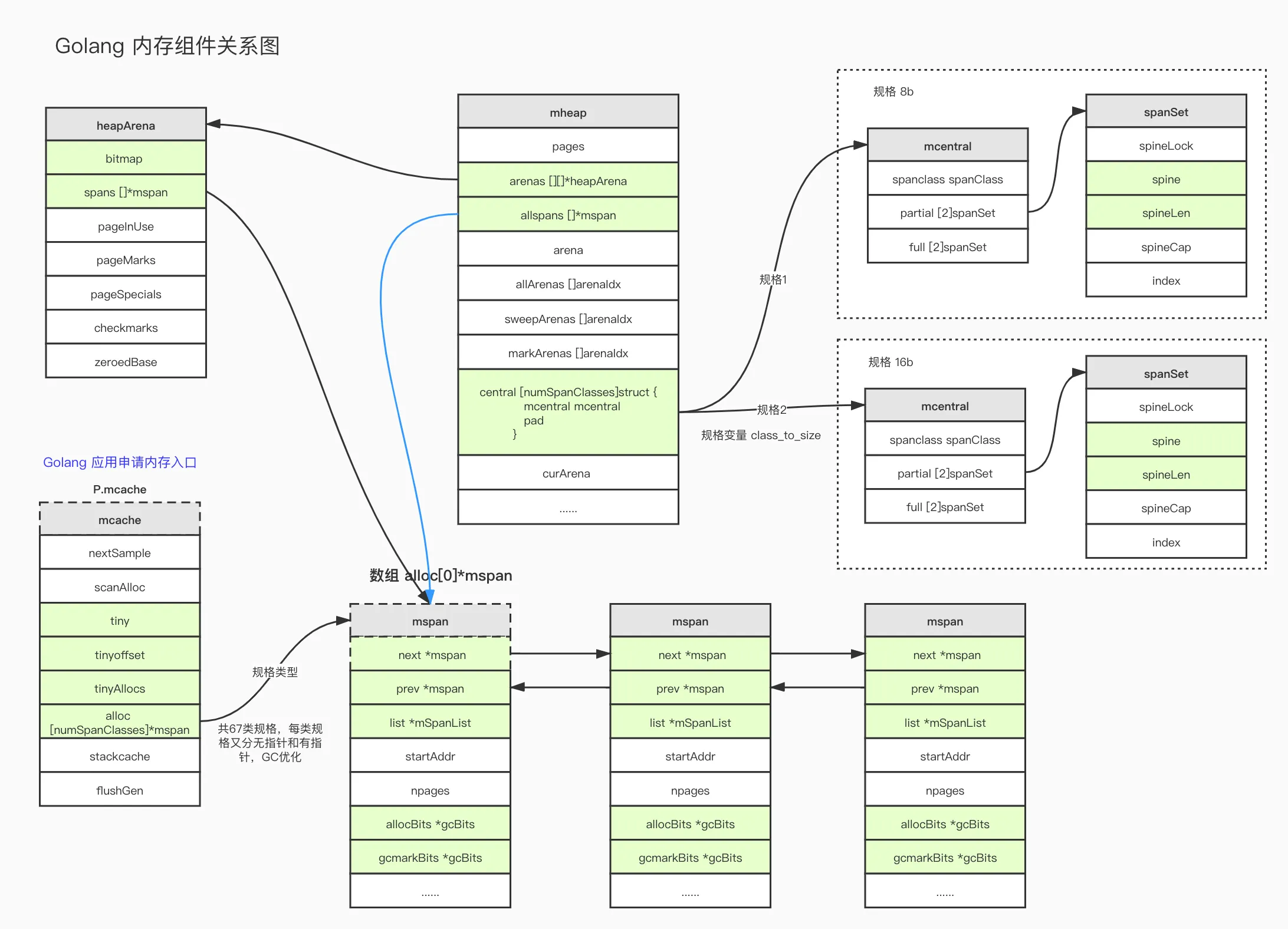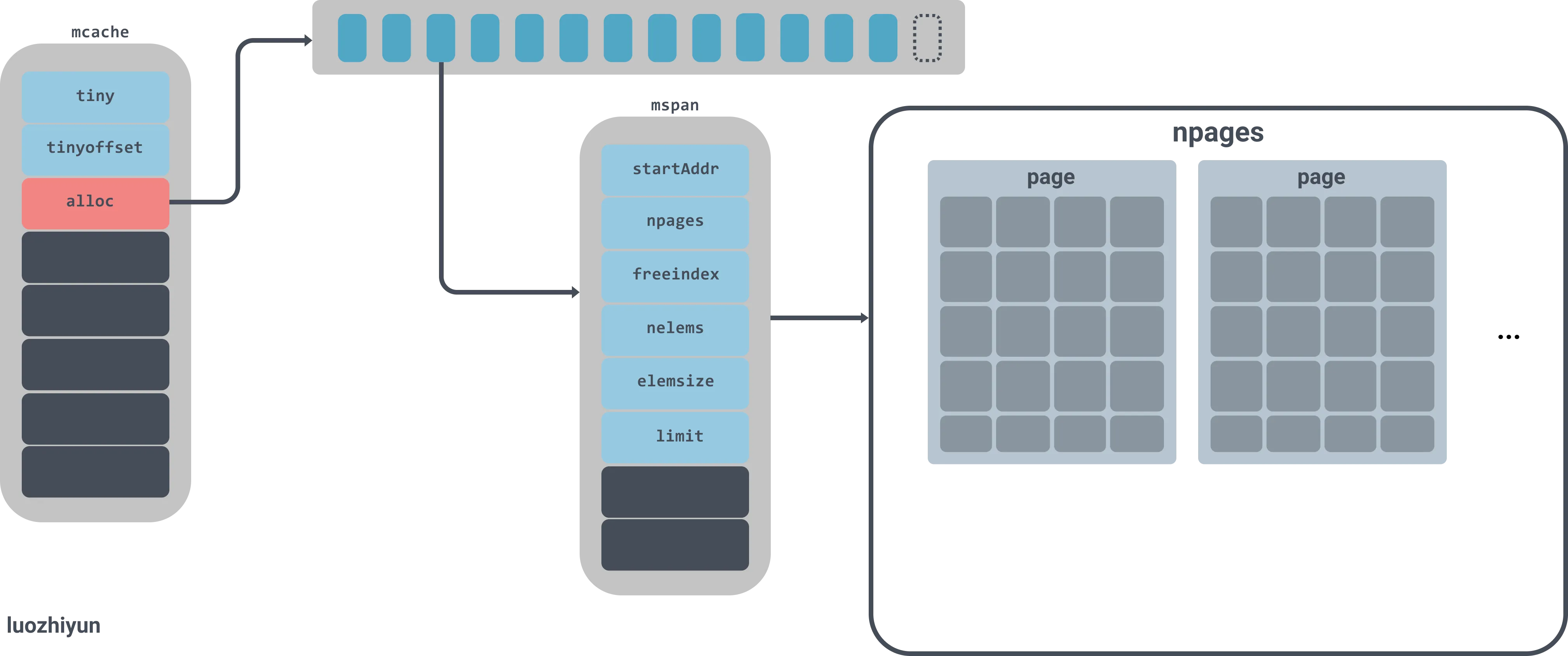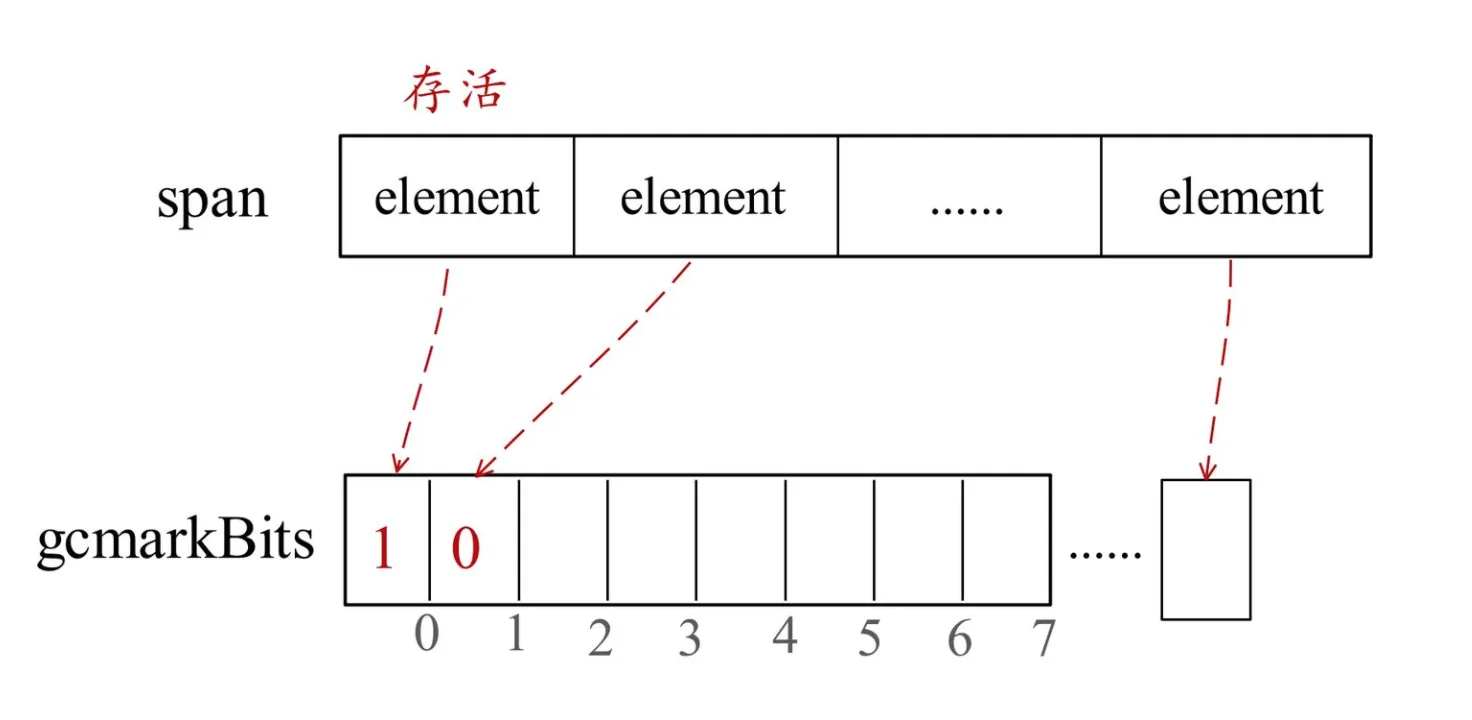GO内存管理:内存组件之mspan、mcache、mcentral 和 mheap 数据结构
作者:互联网
原文:https://blog.haohtml.com/archives/29385
Golang中的内存组件关系如下图所示
 golang 内存分配组件
golang 内存分配组件
在学习golang 内存时,经常会涉及几个重要的数据结构,如果不熟悉它们的情况下,理解起来就显得格外的吃力,所以本篇主要对相关的几个内存组件做下数据结构的介绍。
在 Golang 中,mcache、mspan、mcentral 和 mheap 是内存管理的四大组件,mcache 管理线程在本地缓存的 mspan,而 mcentral 管理着全局的 mspan 为所有 mcache 提供所有线程。
根据分配对象的大小,内部会使用不同的内存分配机制,详细参考函数 mallocgo()
<16KB会使用微小对象内存分配器从P中的mcache分配,主要使用mcache.tinyXXX这类的字段16-32KB从P中的mcache中分配>32KB直接从mheap中分配
对于golang中的内存申请流程,大家应该都非常熟悉了,这里不再进行详细描述。
 Golang 内存组件关系
Golang 内存组件关系
mcache
在GPM关系中,会在每个 P 下都有一个 mcache 字段,用来表示内存信息。
在 Go 1.2 版本以前调度器使用的是 GM 模型,将 mcache 放在了 M 里,但发现存在诸多问题,其中对于内存这一块存在着巨大的浪费。每个 M 都持有 mcache 和 stack alloc,但只有在 M 运行 Go 代码时才需要使用内存(每个 mcache 可以高达2mb),当 M 在处于 syscall 或 网络请求 的时候是不需要内存的,再加上 M 又是允许创建多个的,这就造成了内存的很大浪费。所以从go 1.3版本开始使用了GPM模型,这样在高并发状态下,每个G只有在运行的时候才会使用到内存,而每个 G 会绑定一个P,所以它们在运行只占用一份 mcache,对于 mcache 的数量就是P 的数量,同时并发访问时也不会产生锁。
对于 GM 模型除了上面提供到内存浪费的问题,还有其它问题,如单一全局锁sched.Lock、goroutine 传递问题和内存局部性等。
在 P 中,一个 mcache 除了可以用来缓存小对象外,还包含一些本地分配统计信息。由于在每个P下面都存在一个mcache ,所以多个 goroutine 并发请求内存时是无锁的。
 mcache
mcache
当申请一个 16b 大小的内存时,会优先从运行当前G所在的 P 里的 mcache 字段里找到相匹配的 mspan 规格,是不需要锁的,此时最合适的是图中 mspan3 规格。
mcache是从非GC内存中分配的,所以任何一个堆指针都必须经过特殊处理。源码文件:https://github.com/golang/go/blob/go1.16.2/src/runtime/mcache.go
type mcache struct { // 下方成员会在每次访问malloc时都会被访问,所以为了更加高效缓存将其按组放在这里 nextSample uintptr // trigger heap sample after allocating this many bytes scanAlloc uintptr // bytes of scannable heap allocated // 小对象缓存,<16b。推荐阅读"Tiny allocator"注释文档 tiny uintptr tinyoffset uintptr tinyAllocs uintptr // 下方成员不会在每次 malloc 时被访问 alloc [numSpanClasses]*mspan // spans to allocate from, indexed by spanClass stackcache [_NumStackOrders]stackfreelist flushGen uint32 }nextSample分配多少大小的堆时触发堆采样;scannAlloc分配的可扫描堆字节数;tiny堆指针,指向当前tiny块的起始指针,如果当前无tiny块则为nil。在终止标记期间,通过调用mcache.releaseAll()来清除它;tinyoffset当前tiny 块的位置;tinyAllocs拥有当前mcache的 P 执行的微小分配数;alloc [numSpanClasses]*mspan当前P的分配规格信息,共numSpanClasses = _NumSizeClasses << 1种规格,每个规格的都存在两份,一个包含指针,另一个不包含指针,GC时只对包含指针的这份进行处理stackcache内存规格序号,按spanClass索引,参考这里;flushGen表示上次刷新mcache的sweepgen(清扫生成)。如果flushGen != mheap_.sweepgen则说明mcache已过期需要刷新,需被被清扫。在acrequirep中完成;
mcache.tiny 是一个指针,当申请对象大小为 <16KB 的时候,会使用 Tiny allocator 分配器,会根据tiny、tinyoffset 和 tinyAllocs 这三个字段的情况进行申请。
span 大小规格数据共有 67 类。源码里定义的虽然是 _NumSizeClasses = 68 类,但其中包含一个大小为 0 的规格,此规格表示大对象,即 >32KB,此种对象只会分配到heap上,所以不可能出现在 mcache.alloc 中。
mcache.alloc 是一个数组,值为 *spans 类型,它是 go 中管理内存的基本单元。对于16-32 kb大小的内存都会使用这个数组里的的 spans 中分配。每个span存在两次,一个不包含指针的对象列表和另一个包含指针的对象列表。这种区别将使垃圾收集的工作更容易,因为它不必扫描不包含任何指针的范围。
mspan
mspan 是分配内存时的基本单元。当分配内存时,会在mcache中查找适合规格的可用 mspan,此时不需要加锁,因此分配效率极高。
Go将内存块分为大小不同的 67 种,然后再把这 67 种大内存块,逐个分为小块(可以近似理解为大小不同的相当于page)称之为span(连续的page),在go语言中就是上文提及的mspan。
 mspans
mspans
对象分配的时候,根据对象的大小选择大小相近的span。
spans 与 mcache 的关系如下图所示

mspans
// mSpanList heads a linked list of spans.
// 指向spans链表
//go:notinheap
type mSpanList struct {
first *mspan // first span in list, or nil if none
last *mspan // last span in list, or nil if none
}
//go:notinheap
type mspan struct {
next *mspan // next span in list, or nil if none
prev *mspan // previous span in list, or nil if none
list *mSpanList // For debugging. TODO: Remove.
startAddr uintptr // address of first byte of span aka s.base()
npages uintptr // number of pages in span
manualFreeList gclinkptr // list of free objects in mSpanManual spans
freeindex uintptr
nelems uintptr // number of object in the span.
allocCache uint64
allocBits *gcBits
gcmarkBits *gcBits
// sweep generation:
// if sweepgen == h->sweepgen - 2, the span needs sweeping
// if sweepgen == h->sweepgen - 1, the span is currently being swept
// if sweepgen == h->sweepgen, the span is swept and ready to use
// if sweepgen == h->sweepgen + 1, the span was cached before sweep began and is still cached, and needs sweeping
// if sweepgen == h->sweepgen + 3, the span was swept and then cached and is still cached
// h->sweepgen is incremented by 2 after every GC
sweepgen uint32
divMul uint16 // for divide by elemsize - divMagic.mul
baseMask uint16 // if non-0, elemsize is a power of 2, & this will get object allocation base
allocCount uint16 // number of allocated objects
spanclass spanClass // size class and noscan (uint8)
state mSpanStateBox // mSpanInUse etc; accessed atomically (get/set methods)
needzero uint8 // needs to be zeroed before allocation
divShift uint8 // for divide by elemsize - divMagic.shift
divShift2 uint8 // for divide by elemsize - divMagic.shift2
elemsize uintptr // computed from sizeclass or from npages
limit uintptr // end of data in span
speciallock mutex // guards specials list
specials *special // linked list of special records sorted by offset.
}
mSpanList 是一个mspans链表,这个很好理解。重点看下 mspan 结构体
next指向下一个span的指针,为nil表示没有prev指向上一个span的指针,与next相反list指向mSpanList,调试使用,以后会废弃startAddrspan第一个字节地址,可通过s.base()函数读取npagesspan中的页数(一个span是由多个page组成的,与linux中的页不是同一个概念)manualFreeList在mSpanManualspans中的空闲对象的列表freeindex标记0~nelems之间的插槽索引,标记的的是在span中的下一个空闲对象;
每次分配内存都从allocBits的freeindex索引位置开始,直到遇到0,表示空闲对象,然后调整freeindex使得下一次扫描能跳过上一次的分配;
若freeindex==nelem,则当前span没有了空余对象;
allocBits 是对象在span中的位图;
如果n >= freeindex and allocBits[n/8] & (1<<(n%8)) == 0, 那么对象n是空闲的;
否则,对象 n 表示已被分配。从 elem 开始的是未定义的,将不应该被定义;nelemsspan中对象数(page是内存存储的基本单元, 一个span由多个page组成,同时一个对象可能占用一个或多个page);allocCache在freeindex位置的allocBits缓存;allocBits标记span中的elem哪些是“被使用”了的,哪些是未被使用的;清除后将释放allocBits,并将allocBits的值设置为gcmarkBits;gcmarkBits标记span中的elem哪些是“被标记”了的,哪些是未被标记的;spanclassspanClass类型;state由于协程栈也是从堆上分配的,也在mheap管理的这些span中,mspan.spanState会记录该span是用作堆内存,还是用作栈内存;
每个 mspan 都对应两个位图标记:mspan.allocBits 和 mspan.gcmarkBits。
(1)allocBits中每一位用于标记一个对象存储单元是否已分配。
 allocBits
allocBits
(2)gcmarkBits中每一位用于标记一个对象是否存活。
 gcMarkBits
gcMarkBits
03. Golang中GC的三色标记
- (1)着为灰色对应的操作就是把指针对应的
gcmarkBits标记位置为1并加入工作队列。 - (2)着为黑色对应的操作就是把对象对应的
gcmarkBits标记位置为1。 - (3)白色对象就是那些
gcmarkBits中标记为0的对象。
mcentral
mentral 是一个空闲列表。
实际上 mcentral 它并不包含空闲对象列表,真正包含的是 mspan 。
每个mcentral 是两个 mspans 列表:空闲对象 c->notempty 和 完全分配对象 c->empty,如图所示
 mcentral
mcentral
当申请一个 16b 大小的内存时,如果 p.mcache 中无可用大小内存时,则它找一个最合适的规则 mcentral 查找,如图所示这时会在存放16b大小的 mcentral 中的 notempty 里查找。
文件源码:https://github.com/golang/go/blob/go1.16.2/src/runtime/mcentral.go
type mcentral struct {
spanclass spanClass
partial [2]spanSet // list of spans with a free object
full [2]spanSet // list of spans with no free objects
}
spanClass指当前规格大小partial存在空闲对象spans列表full无空闲对象spans列表
其中 partial 和 full 都包含两个 spans 集数组。一个用在扫描 spans,另一个用在未扫描spans。在每轮GC期间都扮演着不同的角色。mheap_.sweepgen 在每轮gc期间都会递增2。
partial 和 full 的数据类型为 spanSet,表示 *mspans 集。
对 mcentral 的初始化如下
// Initialize a single central free list.
func (c *mcentral) init(spc spanClass) {
c.spanclass = spc
lockInit(&c.partial[0].spineLock, lockRankSpanSetSpine)
lockInit(&c.partial[1].spineLock, lockRankSpanSetSpine)
lockInit(&c.full[0].spineLock, lockRankSpanSetSpine)
lockInit(&c.full[1].spineLock, lockRankSpanSetSpine)
}
mheap
还是上面的例子,假如申请 16b 内存时,依次经过 mcache 和 mcentral 都没有可用适宜规则的大小内存,这时候会向 mheap 申请一块内存。然后按指定规格划分为一些列表,并将其添加到相同规格大小的 mcentral 的 not empty list 后面;
 mheap
mheap
Go 没法使用工作线程的本地缓存 mcache 和全局中心缓存 mcentral 上管理超过32KB的内存分配,所以对于那些超过32KB的内存申请,会直接从堆上(mheap)上分配对应的数量的内存页(每页大小是8KB)给程序。
type mheap struct {
// lock must only be acquired on the system stack, otherwise a g
// could self-deadlock if its stack grows with the lock held.
lock mutex
pages pageAlloc // page allocation data structure
sweepgen uint32 // sweep generation, see comment in mspan; written during STW
sweepdone uint32 // all spans are swept
sweepers uint32 // number of active sweepone calls
allspans []*mspan // all spans out there
_ uint32 // align uint64 fields on 32-bit for atomics
// Proportional sweep
pagesInUse uint64 // pages of spans in stats mSpanInUse; updated atomically
pagesSwept uint64 // pages swept this cycle; updated atomically
pagesSweptBasis uint64 // pagesSwept to use as the origin of the sweep ratio; updated atomically
sweepHeapLiveBasis uint64 // value of heap_live to use as the origin of sweep ratio; written with lock, read without
sweepPagesPerByte float64 // proportional sweep ratio; written with lock, read without
scavengeGoal uint64
// Page reclaimer state
// This is accessed atomically.
reclaimIndex uint64
// This is accessed atomically.
reclaimCredit uintptr
arenas [1 << arenaL1Bits]*[1 << arenaL2Bits]*heapArena
heapArenaAlloc linearAlloc
arenaHints *arenaHint
arena linearAlloc
allArenas []arenaIdx
sweepArenas []arenaIdx
markArenas []arenaIdx
curArena struct {
base, end uintptr
}
_ uint32 // ensure 64-bit alignment of central
central [numSpanClasses]struct {
mcentral mcentral
pad [cpu.CacheLinePadSize - unsafe.Sizeof(mcentral{})%cpu.CacheLinePadSize]byte
}
spanalloc fixalloc // allocator for span*
cachealloc fixalloc // allocator for mcache*
specialfinalizeralloc fixalloc // allocator for specialfinalizer*
specialprofilealloc fixalloc // allocator for specialprofile*
speciallock mutex // lock for special record allocators.
arenaHintAlloc fixalloc // allocator for arenaHints
unused *specialfinalizer // never set, just here to force the specialfinalizer type into DWARF
}
var mheap_ mheap
lock全局锁,保证并发,所以尽量避免从mheap中分配pages页面分配的数据结构sweepgen清扫生成sweepdone清扫完成标记sweepers活动清扫调用 sweepone 数allspans所有的 spans 都是通过mheap_申请,所有申请过的mspan都会记录在allspans。结构体中的lock就是用来保证并发安全的。pagesInUse统计mSpanInUse中spans的页数pagesSwept本轮清扫的页数pagesSweptBasis用作清扫率sweepHeapLiveBasis用作扫描率的heap_live 值sweepPagesPerByte清扫率scavengeGoal保留的堆内存总量(预先设定的),runtime 将试图返还内存给OSreclaimIndex指回收的下一页在allAreans 中的索引。具体来说,它指的是arena allArenas[i/pagesPerArena]的第(i%pagesPerArena)页reclaimCredit多余页面的备用信用。因为页回收器工作在大块中,它可能回收的比请求的要多,释放的任何备用页将转到此信用池arenas [1 << arenaL1Bits]*[1 << arenaL2Bits]*heapArena重要字段!堆arena 映射。它指向整个可用虚拟地址空间的每个 arena 帧的堆元数据;
使用arenaIndex将索引计算到此数组中;
对于没有Go堆支持的地址空间区域,arena映射包含nil;
一般来说,这是一个两级映射,由一个L1级映射和多个L2级映射组成;
当有大量的的 arena 帧时将节省空间,然而在许多平台(64位),arenaL1Bits 是0,这实际上是一个单级映射。这种情况下arenas[0]永远不会为零。heapArenaAlloc是为分配heapArena对象而预先保留的空间。仅仅用于32位系统。arenaHints试图添加更多堆 arenas 的地址列表。它最初由一组通用少许地址填充,并随实heap arena的界限而增长。arenalinearAllocallArenas[]arenaIdx是每个映射arena的arenaIndex 索引。可以用以遍历地址空间。sweepArenas []arenaIdx指在清扫周期开始时保留的allArenas快照markArenas []arenaIdx指在标记周期开始时保留的allArenas快照curArena指heap当前增长时的arena,它总是与physPageSize对齐。central重要字段!这个就是上面介绍的mcentral,每种规格大小的块对应一个mcentral。pad 是一个字节填充,用来避免伪共享(false sharing)spanalloc数据类型fixalloc是 free-list,用来分配特定大小的块。比如cachealloc分配mcache大小的块。cachealloc同上- 其它
对于 mheap.arenas 字段对应 heapArena类型, 用来存储 heap arena 元数据,存储在Go堆的外部,并通过 mheap.arenas 索引进行访问。
// A heapArena stores metadata for a heap arena. heapArenas are stored
// outside of the Go heap and accessed via the mheap_.arenas index.
//
//go:notinheap
type heapArena struct {
bitmap [heapArenaBitmapBytes]byte
spans [pagesPerArena]*mspan
pageInUse [pagesPerArena / 8]uint8
pageMarks [pagesPerArena / 8]uint8
pageSpecials [pagesPerArena / 8]uint8
checkmarks *checkmarksMap
zeroedBase uintptr
}
heapArena.bitmap中每两个bit对应标记arena中一个指针大小的word(也就是说bitmap中一个byte即 8 个位可以标记arena中连续四个指针大小的内存);
每个word对应的两个bit中,低位bit用于标记是否为指针,0为非指针,1为指针;
高位bit用于标记是否要继续扫描,高位bit为1就代表扫描完当前word并不能完成当前数据对象的扫描;
 HeapArena.bitmap
HeapArena.bitmap
heapArena.spans是一个*mspan类型的数组,用于记录当前arena中每一页对应到哪一个mspan。
 HeapArena.spans
HeapArena.spans
heapArena.pageInUse位图类型,指哪些spans 处于 mSpanInUse 状态;heapArena.pageMarks位图类型,指哪些 spans 已被标记。与pageInUse类似,但只使用每个span中的首页的位;heapArena.pageSpecials位图类型,指哪些spans有specials (finalizers or other).与pageInUse类似,但只使用每个span中的首页的位;heapArena.checkmarks调度使用,仅在debug.gccheckmark > 0时使用。检查存储debug.gccheckmark状态;heapArena.zeroedBase标记在arena 首页的第一个字节,未使用
基于 HeapArena 记录的元数据信息,我们只要知道一个对象的地址,就可以根据 HeapArena.bitmap 信息扫描它内部是否含有指针;也可以根据对象地址计算出它在哪一页,然后通过 HeapArena.spans 信息查到该对象存在哪一个mspan中。
对于heap结构中的字段比较多,有几个使用频率非常高的字段,如 allspans、arenas、allArenas、sweepArenas、markArenas 和 central 。有些是与GC 有关,有些是与内存维护管理有关。随着阅读runtime的时间,会越来越了解每个字段的使用场景。
参考资料
- https://studygolang.com/articles/29752
- https://zhuanlan.zhihu.com/p/338203758
- https://www.cnblogs.com/shijingxiang/articles/12196677.html
- http://www.voidcn.com/article/p-yhcodasw-bkx.html
- https://www.cnblogs.com/zpcoding/p/13259943.html#_label1_4
- https://www.dazhuanlan.com/2019/09/29/5d900b0173983/
- https://www.luozhiyun.com/archives/434
标签:span,mcentral,mcache,内存,spans,mspan,mheap 来源: https://www.cnblogs.com/shiqi17/p/16260438.html